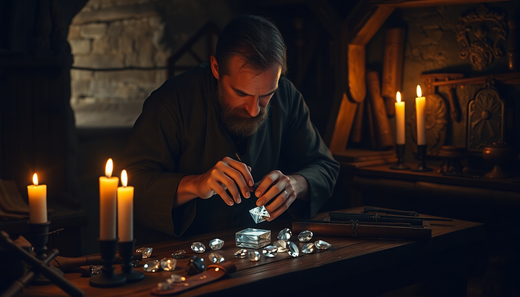
The Fascinating Art of Faceting in Medieval Times
Share
In the captivating world of gemstone cutting, the art of faceting has a rich and storied history that can be traced back to the medieval era. While today's advanced technology has revolutionized the process, it's fascinating to delve into the techniques and tools used by the skilled artisans of the past.
Faceting, the intricate process of shaping and polishing a gemstone to enhance its natural beauty, was a highly revered craft in medieval times. Unlike the modern-day automated methods, the medieval faceting process was a labor-intensive and meticulous endeavor, requiring immense skill and patience.
The tools used by these medieval gem cutters were relatively simple, yet remarkably effective. The primary instrument was a simple lap, a rotating wheel made of wood or metal, which was used to grind and polish the gemstone's surfaces. These laps were often powered by a foot-operated treadle, allowing the artisan to control the speed and pressure with precision.
Alongside the lap, medieval facetors employed a variety of other tools, including hand-held dops (holders) to secure the gemstone, and a range of abrasives such as sand, emery, and even diamond dust to gradually shape and refine the stone. The process was often painstakingly slow, with each facet meticulously carved and polished to perfection.
One of the most remarkable aspects of medieval faceting was the level of skill and artistry involved. These craftsmen possessed an intimate understanding of the unique properties of each gemstone, from their hardness and cleavage to their optical characteristics. This knowledge allowed them to create intricate and visually stunning designs, often incorporating symmetrical patterns and precise angles to maximize the stone's brilliance and fire.
The legacy of these medieval facetors can still be seen in the work of modern-day gem cutters, who continue to draw inspiration from the timeless techniques and aesthetics of the past. As we marvel at the dazzling gemstones of today, it's important to remember the skilled hands and unwavering dedication of the artisans who paved the way, transforming raw materials into true works of art.
So, the next time you admire the captivating sparkle of a faceted gemstone, take a moment to appreciate the rich history and the skilled craftsmanship that has made such beauty possible. The art of faceting may have evolved, but its essence remains a testament to the enduring human spirit and the pursuit of perfection.
The Rise of Faceting in Medieval Europe
The art of faceting gemstones gained significant momentum during the medieval period, particularly in Europe. As trade routes expanded and the demand for luxurious goods increased, the need for skilled gem cutters grew. Artisans from various regions, such as Flanders, Bohemia, and Italy, began to hone their craft, developing innovative techniques and designs that would captivate the elite and wealthy.
The Influence of Islamic Faceting Traditions
One of the key factors that contributed to the advancement of faceting in medieval Europe was the influence of Islamic faceting traditions. Through trade and cultural exchange, European gem cutters were exposed to the intricate and sophisticated faceting methods practiced in the Islamic world. This cross-pollination of ideas and techniques helped to push the boundaries of what was possible in the art of gemstone cutting.
The Emergence of Specialized Workshops
As the demand for faceted gemstones increased, specialized workshops began to emerge across Europe. These workshops, often family-owned and passed down through generations, became centers of excellence, where master facetors trained apprentices and developed new cutting techniques. The competition between these workshops fueled innovation and the creation of increasingly complex and visually stunning designs.
The Legacy of Medieval Faceting
The impact of medieval faceting on the world of gemstones and jewelry is undeniable. The skills and techniques developed during this period laid the foundation for the modern faceting industry, inspiring generations of gem cutters to push the boundaries of their craft. Today, we can still see the influence of medieval faceting in the intricate designs and precise angles that adorn some of the most prized gemstones in the world.
As we continue to marvel at the beauty of faceted gemstones, it's important to remember the rich history and the skilled artisans who dedicated their lives to perfecting this captivating art form. The legacy of medieval faceting serves as a testament to the enduring human spirit and the pursuit of beauty through the transformation of raw materials into true works of art.